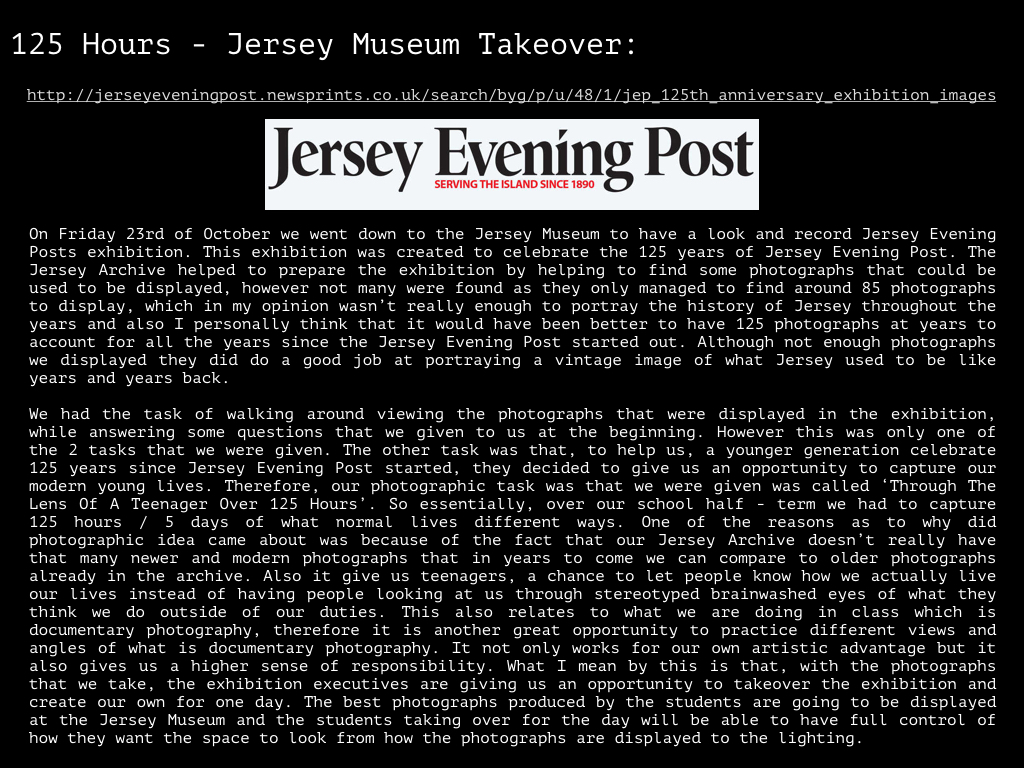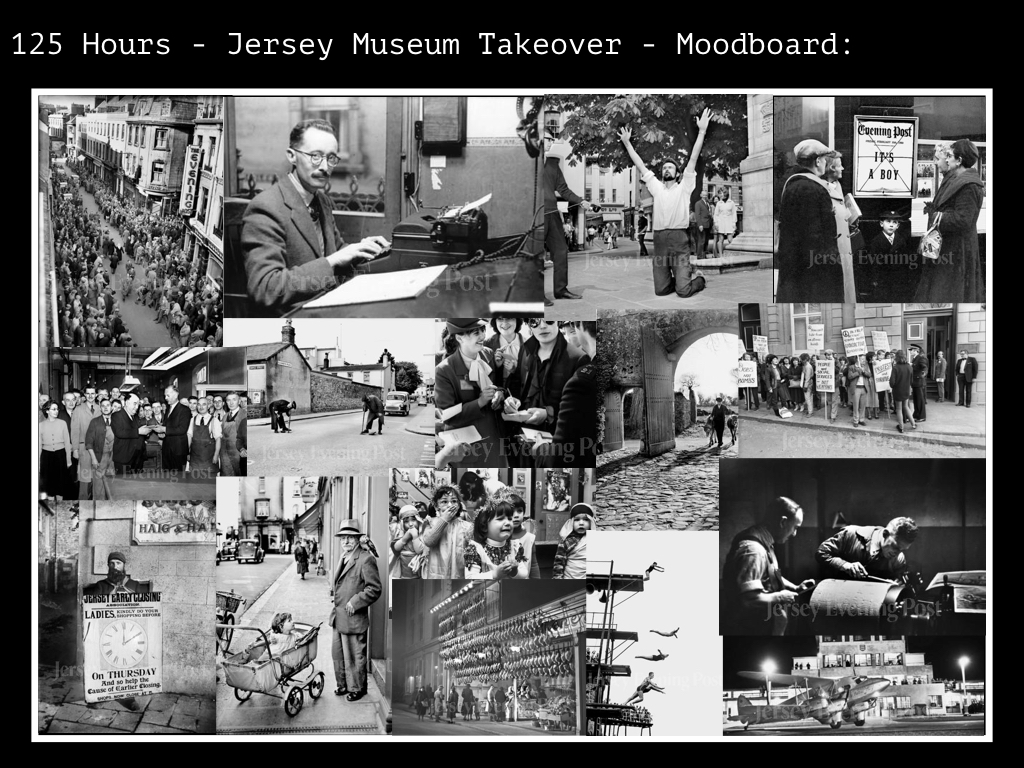Your task is to use images from your current personal project and/ or photographs made in response to the JEP exhibition at Jersey Museum brief: Our Story, Half Term: 125 hours seen through a teenager’s lens and produce at least two different designs and picture stories.
Use Tracking Sheets to monitor your progress. You must annotate it and upload onto your blog every Friday!
TRACKING SHEET 1st H-TERM
TRACKING SHEET 2nd H-TERM
Blog: Produce a number of posts that show evidence of the following:
Week 2 – 9 Nov – JEP exhibition and responses
1. Exhibition review: Upload image analysis and answers from Task Sheet given to you at the JEP exhibition. Download sheet here: Takeover Exhibition Task.
Here is a link to all images from exhibition: http://jerseyeveningpost.newsprints.co.uk/search/byg/p/u/48/1/jep_125th_anniversary_exhibition_images or see my blog post: Jersey Museum Takeover for more information.
2. Recording and editing: Upload images from half-term or any other previous shoots and produce contact sheets. Using Lightroom, edit a selection of your 10-12 best photographs. Show experimentation with image adjustments, colour/ B&W and annotate.
3. Evaluation and further development: Reflect on your shoots, project and planning. Have you got enough photographs and variety of images to tell your story and begin to design picture stories next week ? Is anything missing? Think about what you want to achieve, what you want to communicate, how your ideas relate to the themes of FAITH, FAMILY and COMMUNITY? Do you need to provide more contextual studies to develop your ideas, interpret other artists and photographers work? DO YOU NEED TO TAKE MORE PHOTOGRAPHS? You got this week and weekend to do it!
4. Submission to Jersey Museum: Choose a final edit of no more than 3 images that work together as a coherent series with a clear personal identity or visual narrative.
DEADLINE: Wed 18th November
Week 9 – 23 Nov – Designing a picture story
1. Research Picture-Stories: Produce a mood board of newspaper layouts and magazine style picture stories. For reference use look at local stories from the JEP as well as international stories from magazine supplements in UK broadsheets newspaper ( e.g. The Sunday Times, The Guardian, The Telegraphs, Financial Times etc). Look at also at digital picture stories from the internet (see photo-agency websites: Lensculture, Magnum Photos, World Press Photo, AgenceVU, Panos Pictures. Alec Soth’s LBM Dispatch
Find picture-stories here in this folder: M:\Departments\Photography\Students\Resources\Documentary & Narrative\picture-stories
2. Analysis and deconstruction: Look at the layout of pictures and analyse how individual pictures relate and tell a story according to the construction of a traditional picture-story. Identify what types of pictures are more important than others e.g. which are major (establishing shots) or minor pictures (detail, relationship shot), and which types of portraits are used (formal, informal, environmental and person at work) see Powerpoint: A Traditional Picture Story below for further guidance. Analyse also the use of headline, text and captions to convey and construct a particular meaning or point of view.
The Traditional Picture Story_v1
3. Headline, text, captions: Think of a creative title and write a selection of headlines that tell your story. Write also an introduction/ abstract that provide further context for your pictures story. Also write captions for each picture: who, what, where, when and put into a new post
4. A3 Page-Spread Designs: Produce at least two different designs/ picture-stories from your photographs. Class tutorial on page design using Photoshop; how to use headlines and major and minor images. Be creative in your layout and experiment with different ways to communicate your message by clever cropping, sequencing, juxta-positioning, typography, use of graphics etc. Start with a rough sketch of how the page might work and begin to lay out pictures, major and minors.
a) Design a traditional newspaper layout
b) Design a magazine double-page spread
5. Experimentation: Edit your final layout and designs – make sure you show experimentation in your blog of different design and layout ideas combining images, graphics and typography in a personal and creative manner. Produce at least 3 versions of each design
6. Evaluation: Reflect on your final design ideas and explain in some detail how well you realised your intentions and reflect on what you learned/ What could you improve? How?
7. Presentation: Print, mount and present final designs and other final outcomes, such your best 3-5 images and present as final prints. Save everything in a folder in your name in Image Transfer on Silverstore
NB: Upload any video/podcast to Youtube and imbed in your Blog































